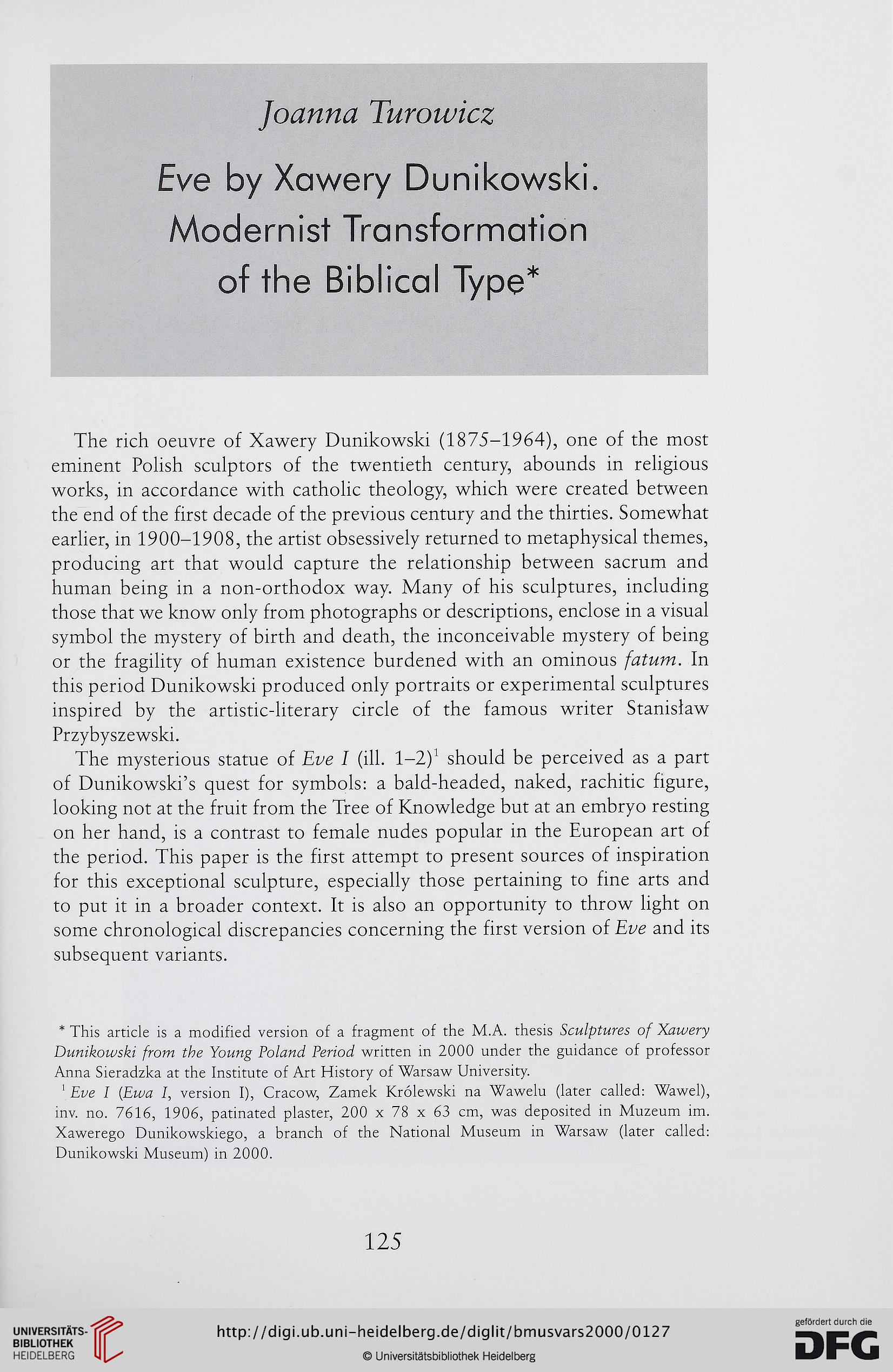Joanna Turowicz
Eve by Xawery Dunikowski.
Modernist Transformation
of the Biblical Type*
The rich oeuvre of Xawery Dunikowski (1875-1964), one of the most
eminent Polish sculptors of the twentieth century, abounds in religious
works, in accordance with catholic theology, which were created between
the end of the first decade of the previous century and the thirties. Somewhat
earlier, in 1900-1908, the artist obsessively returned to metaphysical themes,
producing art that would capture the relationship between sacrum and
human being in a non-orthodox way. Many of his sculptures, including
those that we know only from photographs or descriptions, enclose in a visual
symbol the mystery of birth and death, the inconceivable mystery of being
or the fragility of human existence burdened with an ominous fatum. In
this period Dunikowski produced only portraits or experimental sculptures
inspired by the artistic-literary circle of the famous writer Stanisław
Przybyszewski.
The mysterious statuę of Eve I (ill. 1-2)' should be perceived as a part
of Dunikowskie ąuest for symbols: a bald-headed, naked, rachitic figurę,
looking not at the fruit from the Tree of Knowledge but at an embryo resting
on her hand, is a contrast to female nudes popular in the European art of
the period. This paper is the first attempt to present sources of inspiration
for this exceptional sculpture, especially those pertaining to fine arts and
to put it in a broader context. It is also an opportunity to throw light on
some chronological discrepancies concerning the first version of Eve and its
subseąuent yariants.
* This article is a modified version of a fragment of the M.A. thesis Sculptures of Xawery
Dunikowski from the Young Poland Period written in 2000 under the guidance of professor
Anna Sieradzka at the Institute of Art History of Warsaw University.
' Eve I (Ewa I, version I), Cracow, Zamek Królewski na Wawelu (later called: Wawel),
inv. no. 7616, 1906, patinated plaster, 200 x 78 x 63 cm, was deposited in Muzeum im.
Xawerego Dunikowskiego, a branch of the National Museum in Warsaw (later called:
Dunikowski Museum) in 2000.
125
Eve by Xawery Dunikowski.
Modernist Transformation
of the Biblical Type*
The rich oeuvre of Xawery Dunikowski (1875-1964), one of the most
eminent Polish sculptors of the twentieth century, abounds in religious
works, in accordance with catholic theology, which were created between
the end of the first decade of the previous century and the thirties. Somewhat
earlier, in 1900-1908, the artist obsessively returned to metaphysical themes,
producing art that would capture the relationship between sacrum and
human being in a non-orthodox way. Many of his sculptures, including
those that we know only from photographs or descriptions, enclose in a visual
symbol the mystery of birth and death, the inconceivable mystery of being
or the fragility of human existence burdened with an ominous fatum. In
this period Dunikowski produced only portraits or experimental sculptures
inspired by the artistic-literary circle of the famous writer Stanisław
Przybyszewski.
The mysterious statuę of Eve I (ill. 1-2)' should be perceived as a part
of Dunikowskie ąuest for symbols: a bald-headed, naked, rachitic figurę,
looking not at the fruit from the Tree of Knowledge but at an embryo resting
on her hand, is a contrast to female nudes popular in the European art of
the period. This paper is the first attempt to present sources of inspiration
for this exceptional sculpture, especially those pertaining to fine arts and
to put it in a broader context. It is also an opportunity to throw light on
some chronological discrepancies concerning the first version of Eve and its
subseąuent yariants.
* This article is a modified version of a fragment of the M.A. thesis Sculptures of Xawery
Dunikowski from the Young Poland Period written in 2000 under the guidance of professor
Anna Sieradzka at the Institute of Art History of Warsaw University.
' Eve I (Ewa I, version I), Cracow, Zamek Królewski na Wawelu (later called: Wawel),
inv. no. 7616, 1906, patinated plaster, 200 x 78 x 63 cm, was deposited in Muzeum im.
Xawerego Dunikowskiego, a branch of the National Museum in Warsaw (later called:
Dunikowski Museum) in 2000.
125





